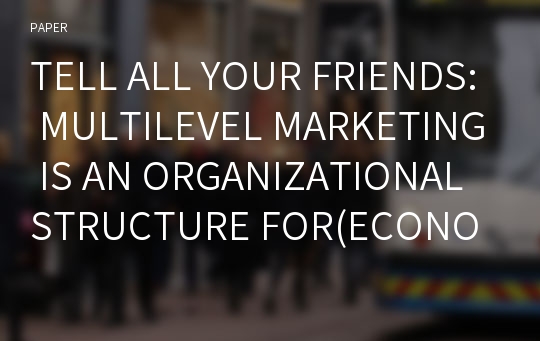TELL ALL YOUR FRIENDS: MULTILEVEL MARKETING IS AN ORGANIZATIONAL STRUCTURE FOR(ECONOMIC AND PERSONAL) GROWTH
* 본 문서는 배포용으로 복사 및 편집이 불가합니다.
서지정보
ㆍ발행기관 : 글로벌지식마케팅경영학회(GFMC)
ㆍ수록지정보 : Global Marketing Conference
ㆍ저자명 : Steven W. Kopp
ㆍ저자명 : Steven W. Kopp
영어 초록
Introduction The research described in this abstract discusses “multilevel marketing,” including a review of academic literatures and studies that have used the direct sales business method as a research context. The multilevel marketing business structure represents an alternative to the business-employee-consumer relationships of those offered by traditional bureaucratic organizations. As such, they have, on one hand, collectively prospered and, on the other hand, attracted negative attention from regulatory and government entities, scholars, and competitors. Studies related to MLM organizations have examined these businesses on every populated continent, and have considered the viewpoints of consumers, MLM participants, and sales managers. Research has included a variety of empirical approaches, from quantitative survey methods to qualitative ethnographic studies. Consumer dispositions toward MLM have been measured intermittently over several years, and include consumer responses from many different countries. One consistent finding is that people who have purchased products from MLMs expressed more favorable opinions of them than do those who have not bought from MLM. Further, studies also provide evidence that consumers perceive that buying from direct selling is perceived to be less risky than some other non-store shopping modes (Gillett, 1976; Peterson, Albaum & Ridgway 1989; Alturas, Santos & Pereira 2005). Nonetheless, the practice is controversial and faces intense scrutiny in many countries while being banned in others. However, the research literature suggests careful consideration of the benefits of MLM organizations, in that the nontraditional organizational structure and methods of promotion may provide economic development in poor economies and also allow consumer-participants to develop important skills. One common method of retailing is direct sales. Direct selling companies emphasize promotion and distribution of their products through person-to-person contact, usually away from a physical retail location and usually through some network of independent sellers. The sales presentations are often held in homes, in the form of door-to-door solicitation, one-to-one meetings, through sales “parties,” or through some type of online social media platform (e.g., Facebook). Direct selling provides a channel of distribution for companies as an alternative to traditional retail outlets; it is attractive to companies that may be unable to compete with the vast advertising and promotion expenses that other manufacturers employ to gain shelf space in traditional retail stores. The variety of products and services that are sold through direct sales matches that of major traditional retailers, including cosmetics, home décor, wellness, jewelry, kitchen products, clothing, organic gardening, and scrapbooking supplies. Promotion of the products often relies on product demonstrations. One type of direct sales is multilevel marketing. A multilevel marketing organization (MLM) is a type of compensation structure (Coughlan & Grayson 1998) through which distributors earn income from their own sales as well as through commissions from the sales made by individuals they have recruited into their organization. As depicted in Figure 1, there are three basic components to compensation: 1. Distributors purchase the products or services at wholesale cost from the MLM organization; these products are sold at a profit (markup) to end consumers 2. Distributors are paid a commission by the MLM for what they sell directly 3. Distributors earn a bonus (percentage) of the sales made by individuals they recruit into the MLM. Recruits are referred to as the distributor’s “downline,” while the recruiter is referred to as the recruited person’s “upline.” MLM and traditional organizations MLM participants include people with diverse backgrounds, levels of education and experience, and personal qualities. Direct selling organizations rely on social connections and relationships to broaden their potential customer base; MLM organizations rely on these social connections as integral to their recruiting as well. MLM organizations do not have formal sales management structures. MLM participants are not “employees,” but rather act as independent franchisees that must adhere to organizational, ethical, and legal parameters. MLM participants are usually not co-located – they do not work at a central office – and often begin work part-time. Participants usually pay start-up or membership fees and pay for training and other selling-related materials. Because MLMs operate without bureaucratic organizational structure or traditional workplace, the company’s culture and ideologies are circulated through social relationships of each individual participant. Several researchers have asserted that cultural characteristics have a significant impact on the success of MLMs in any economy. Biggart (1989) observed that MLMs are successful in Asian countries because those societies tend to be very structured and hierarchical, and individuals in those countries carry a Confucian work ethic similar to Protestant ethic characteristic of the United States. Additionally, Asian extended family networks make selling and recruiting easier. By contrast, Herbig and Yelkurm (1997) observed that MLMs have not succeeded in parts of Europe, because the cultural and ideological climate is comparatively unreceptive to free enterprise and market entry. Laws restrict sellers to contact people at home. Southern European countries, however, tend to have larger informal sectors, fewer worker protections and restrictions, and stronger family and extended-family relationships. Statistics Worldwide, direct retail sales were $182.8 billion in 2014, an increase of over 6% from the previous year; these sales were generated by over 99 million direct-sellingretailers, including cosmetics, home décor, wellness, jewelry, kitchen products, clothing, organic gardening, and scrapbooking supplies. Promotion of the products often relies on product demonstrations. One type of direct sales is multilevel marketing. A multilevel marketing organization (MLM) is a type of compensation structure (Coughlan & Grayson 1998) through which distributors earn income from their own sales as well as through commissions from the sales made by individuals they have recruited into their organization. As depicted in Figure 1, there are three basic components to compensation: 1. Distributors purchase the products or services at wholesale cost from the MLM organization; these products are sold at a profit (markup) to end consumers 2. Distributors are paid a commission by the MLM for what they sell directly 3. Distributors earn a bonus (percentage) of the sales made by individuals they recruit into the MLM. Recruits are referred to as the distributor’s “downline,” while the recruiter is referred to as the recruited person’s “upline.” MLM and traditional organizations MLM participants include people with diverse backgrounds, levels of education and experience, and personal qualities. Direct selling organizations rely on social connections and relationships to broaden their potential customer base; MLM organizations rely on these social connections as integral to their recruiting as well. MLM organizations do not have formal sales management structures. MLM participants are not “employees,” but rather act as independent franchisees that must adhere to organizational, ethical, and legal parameters. MLM participants are usually not co-located – they do not work at a central office – and often begin work part-time. Participants usually pay start-up or membership fees and pay for training and other selling-related materials. Because MLMs operate without bureaucratic organizational structure or traditional workplace, the company’s culture and ideologies are circulated through social relationships of each individual participant. Several researchers have asserted that cultural characteristics have a significant impact on the success of MLMs in any economy. Biggart (1989) observed that MLMs are successful in Asian countries because those societies tend to be very structured and hierarchical, and individuals in those countries carry a Confucian work ethic similar to Protestant ethic characteristic of the United States. Additionally, Asian extended family networks make selling and recruiting easier. By contrast, Herbig and Yelkurm (1997) observed that MLMs have not succeeded in parts of Europe, because the cultural and ideological climate is comparatively unreceptive to free enterprise and market entry. Laws restrict sellers to contact people at home. Southern European countries, however, tend to have larger informal sectors, fewer worker protections and restrictions, and stronger family and extended-family relationships. Statistics Worldwide, direct retail sales were $182.8 billion in 2014, an increase of over 6% from the previous year; these sales were generated by over 99 million direct-selling distributors (World Federation of Direct Selling Associations, 2015). The primary product categories included cosmetics/personal care, wellness, household products, and clothing/accessories. The largest markets for direct selling include the United States, Europe, and Japan. The European Direct Selling Association (Seldia) reported that 2014 sales of direct selling firms in European Union countries were €24 billion (about $26.7 billion), with over 5 million direct sellers (Seldia, 2015). In Japan, 2012 direct selling revenues were ¥177 trillion ($16 billion), with 3.3 million participants (WFDSA, 2015). In the United States, there were over 18 million direct-selling distributors in 2014 who generated $34.5 billion, a 5.5% increase from 2013. The Direct Sales Association reported that over 95% of U.S. direct sales in 2011 were through MLMs (Direct Sales Association, 2015). In terms of participation, the vast majority of direct distributors are women in both of two largest aggregate direct-selling markets. In the European Union, 79% of all direct sellers were women in 2014 (Seldia, 2015); seventy-six percent of direct sellers were considered to be part-time. In the U.S., the percentage of female direct sellers in the U.S. in 2014 was 74% (DSA, 2015). Criticism and Legal/Regulatory Issues Legitimate MLMs are often characterized as or confused with illegal “pyramid” or “Ponzi” schemes, and seem to have always attracted regulatory scrutiny (Arun, 2015; Alpert, 2012; Croft, Cutts & Mould, 2000; Hyman, 2008; Herbig & Yelkurm, 1997; O’Regan, 2015). In response to illegitimate operations, consumer protection groups and federal and local governments have provided information and enacted laws which distinguish MLMs from their fraudulent counterparts. MLMs and pyramid schemes Much of the academic and legal literatures have ventured to provide formal delineation between legal MLMs and the illegal and unethical practices related to pyramid schemes (Stockstill, 1985; Coughlan & Grayson, 1998; Epstein, 2010; Vander Nat & Keep, 2002). There is nearly universal concurrence that whether a program is a legitimate multilevel marketing plan or an illegal pyramid depends on: (1) the method by which the products or services are sold; and (2) the manner in which participants are compensated. Basically, if an organization pays participants for sales by their “enrollees,” “recruits,” and/or their downline enrollees and recruits, that plan is multilevel. If a program compensates participants, directly or indirectly, merely for the introduction or enrollment of other participants into the program, unrelated to the sales of any product, it is considered to be a pyramid. In the United States, federal and state anti-pyramid statutes comprise a comprehensive consumer protection umbrella. These laws are designed to protect individuals from being defrauded through illegitimate programs which lure participants with the promise of easy money by compensating them from the investments of additional participants rather than from legitimate product sales. Federal and state regulatory agencies have sought to prohibit such illegal activity using laws that control pyramids, mail fraud, business opportunity, franchise, lottery, and securities. Internationally, many countries ban some forms of pyramid schemes. Pyramid selling and multilevel marketing both take the form of complex organizations, and because of different interpretations of business activities and underlying regulatory philosophies across countries, regulation takes different forms (Micklitz, Monazzahian & Rößler, 1999; Dobson, 2011; Chan, 1999; China Daily, 2013; Epstein, 2010). Economic Development and MLM Organizations Several studies have observed that one of the key reasons for the establishment and growth of MLM organizations has been that they are often introduced into a larger socioeconomic context, using pre-existing social relationships to become engrained in the overall complex of an economy. Indeed, in communities where families and social networks are relatively large and geographically concentrated, MLM organizations have tended to thrive. MLMs are particularly attractive employment options for groups of people who may experience high unemployment and discrimination in the primary labor market (Brodie, Stanworth & Wotruba, 1998), for example women (Biggart, 1989; Casanova, 2011a, 2011b; Vincent, 2003; Dolan & Scott, 2009; Cahn, 2011; Singh & Aggarwal, 2012) and ethnic minorities (Dai, Wang & Teo, 2011; de Vidas, 2008). Further, as many countries attempt to follow a neo-liberalized, free-market approach to economic development, employment has become more feminized (Standing, 1999) and selling for a transnational direct sales organization is often an appealing option for women in developing countries, providing paid employment that takes place not only outside the home, but outside the archetypical, standardized workplace of the export-product manufacturing factory (Casanova, 2011a, 2011b; Wilson, 1998). Other evidence has suggested several macro-environmental developments that continue to have an impact on direct sales organizations (Ingram, 1993; Ragland, 2012). First, the splintering of market segments into subsegments has compelled companies with fewer resources to focus to avoid the “mass market,” and focus instead on smaller segments, tailoring their efforts to gain customer satisfaction (Kotler & Armstrong, 2014). MLMs are particularly suited to this consumer environment – distributors talking directly to consumers to find out what it is that they want, like, and prefer. One further outcome of this fragmentation has been that people have been forced to seek new groups to satisfy their need to belong, and “hybrid” economic social networks such as MLMs satisfy these nonmaterial needs of distributor participants (Green & D’aiuto, 1977). This appears to be a reasonable explanation of why many of the largest MLM organizations have several million distributors, the majority of whom gain only very minimal financial rewards despite devoting a substantial portion of their time to company activities. A second macro trend is that of globalization. Over the past thirty years, a strong demand has developed for Western products in then-newly-opened European and Asian markets. This continues to be the case in central Asia (India, Russia) and Latin America. In addition to consumer demand, a high level of salesperson motivation in those countries cited as a key to success. Thus consumer demand for MLM-supplied products has grown, while the entrepreneurial spirit that multilevel marketing encourages is appealing to many who seek self-managed work and independence from the traditional employer-employee relationship. Third, manufacturers often pursue multiple channels of distribution to make products available, and MLMs offer a realistic (and often creative) alternative component. This makes it easy for shoppers to find what they want, and a “direct” channel can coexist with traditional channels, allowing entry into extremely local markets and extremely poor consumers (Ireland, 2008; Dolan & Scott, 2009). For example, Ireland (2008) provided several examples of the implementation of MLM in poor communities in South America. This strategy was executed by well-known brands, some of which were recognizable MLMs (e.g. Avon) and some of which were traditional consumer products manufacturers (e.g. Coca Cola). The MLM organization in each of these cases emphasized physical distribution – in some situations going so far as to provide refrigerators in the homes of poor consumers, who would then sell beer or soft drinks directly from their homes. Improving access to products involved elaborate multilevel marketing channels that used the social skills and energy of “bottom of pyramid” (very poor) residents who participated as distributors. A fourth macro-level trend has been that toward trust-based relationship marketing, defined as building, developing and maintaining strong relationships with customers and other stakeholders in order to obtain a high profitability through customer satisfaction (Berry, 1983). The success of the MLM business model as a strategic alternative may thus be linked to the macro-level processes in national and global economies. Discussion and Conclusions Modern versions of direct selling hold the potential to improve lives across the world’s developing economies as the range of products begins to include those that have high social value, such as medicines, hygienic items and communications. Multilevel marketing is an innovation that has become increasingly successful as it has evolved in Western economies to include well-known consumer products (Amway, Tupperware, Mary Kay) but also high-end fashion (J. Hilburn, Etcetera) and even sex toys (Passion Parties). In developing countries, the MLM represents a potentially lucrative channel for traditional companies seeking growth – the flexibility of the channel of distribution, the fact that it relies on existing relationships among potential consumers and distributors, and its ability to reach consumers directly make it a potential tool for economic development. Even still, multilevel marketing carries negative connotations in many marketplaces worldwide. Because MLM participants are technically not employees of their company, “control” over participants is difficult, and continued participation is difficult to maintain. The high degree of commitment and strong organizational culture seem to foster accusations of “cult” behaviors. While there is no question that false product or business opportunity claims may be made – as with any consumer product – academic research tends to suggest that prohibition or strict regulation needs to be carefully weighed against the potential benefits of MLM organizational structures and operations. Multilevel marketing and other direct sales channels of distribution may facilitate economic development, first by employing people who may have little business experience, and second by making products available to consumers in markets where few other retailers may be able to reach. Research also suggests that the MLM business method provides a legitimate alternative strategy to traditional retailing: marketers can get information to consumers in ways that are not feasible using traditional advertising or retail distribution, and person-to-person selling increases the likelihood of customer satisfaction.참고 자료
없음"Global Marketing Conference"의 다른 논문
 THE ROLES OF GREEN PACKAGING IN UGLY FOOD PURCHASE INTE..22페이지
THE ROLES OF GREEN PACKAGING IN UGLY FOOD PURCHASE INTE..22페이지 THE IMPACT OF INDUCED AWE ON ETHICAL TOURIST BEHAVIORS5페이지
THE IMPACT OF INDUCED AWE ON ETHICAL TOURIST BEHAVIORS5페이지 A BIBLIOMETRIC ANALYSIS OF SPIRITUAL TOURISM RESEARCH15페이지
A BIBLIOMETRIC ANALYSIS OF SPIRITUAL TOURISM RESEARCH15페이지 SOCIAL NETWORK ANALYSIS AND RESPONSE TIME TESTING: CONS..11페이지
SOCIAL NETWORK ANALYSIS AND RESPONSE TIME TESTING: CONS..11페이지 THE EFFECTS OF PARA-SOCIAL INTERACTION ON ONLINE CELEBR..3페이지
THE EFFECTS OF PARA-SOCIAL INTERACTION ON ONLINE CELEBR..3페이지 THE INFLUENCE OF OPINION LEADERS ON DAILY DEALS USER’S ..3페이지
THE INFLUENCE OF OPINION LEADERS ON DAILY DEALS USER’S ..3페이지 HOW IMMERSIVE RETAILING AFFECTS CONSUMERS’ URGE TO BUY:..6페이지
HOW IMMERSIVE RETAILING AFFECTS CONSUMERS’ URGE TO BUY:..6페이지 KEY TO SUPERSTARDOM IN A GLOBALISED MARKET: THE ROLE OF..6페이지
KEY TO SUPERSTARDOM IN A GLOBALISED MARKET: THE ROLE OF..6페이지 A POST-PANDEMIC LOOK AT TOURISTS’ PERCEIVED COOLNESS OF..4페이지
A POST-PANDEMIC LOOK AT TOURISTS’ PERCEIVED COOLNESS OF..4페이지 EXTRACTING OFFLINE RETAIL SHOPPING PATTERNS: OLLABORATI..5페이지
EXTRACTING OFFLINE RETAIL SHOPPING PATTERNS: OLLABORATI..5페이지




















